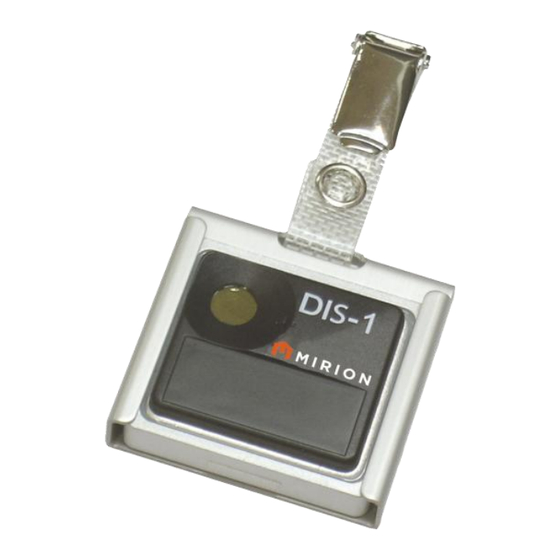
Table of Contents
Advertisement
Quick Links
Advertisement
Table of Contents

Summary of Contents for Mirion Technologies DIS-1
- Page 1 DIS-1 Dosimeter User’s Manual Document Number 2096 6058 Version 1.05...
- Page 2 No part of this document may be copied without written authorisation from the manufacturer. This document is a User’s Manual for the DIS-1 Dosimeter. The manufacturer withholds the right to make changes in the contents of this document without prior notice.
-
Page 3: Table Of Contents
PRINCIPLE OF DIRECT ION STORAGE ....................7 CONSTRUCTION .............................. 8 OPERATION ............................... 9 HARD RESET PROCEDURE ........................11 WEARING THE DIS-1 DOSIMETER ..................... 12 MAINTENANCE AND CALIBRATION ....................13 Calibration ..................... 13 Cleaning of the Electrical Contacts ..............13 Cleaning/Decontamination ................13 Drying the DIS-1 .................... -
Page 4: Introduction
The doses in the DIS-1 dosimeter are read by using the DBR (DIS Badge Reader). To obtain the most recent dose values of Hp(10) and Hp(0.07), the user simply plugs the dosimeter into the reader head and the values are displayed in the display of the reader in a few seconds. -
Page 5: Terminology
The DIS-detection element and the MOSFET-detection based element. There are five elements in the DIS-1: three DIS-elements and two MOSFET-elements. The elements are: DS, DL, DH, SL and SH. These are symbolical names, where the D stands for ‘Deep Dose’... - Page 6 Session Reset Session Reset is an operation, where the new offset dose is measured and stored in the digital memory of the DIS-1. “SR ” measurements are later compared to these stored offset values to give the current doses.
-
Page 7: Principle Of Direct Ion Storage
DIS-1 Dosimeter User’s Manual Doc. No 2096 6058, Ver. 1.05, 17. 11. 2014 PRINCIPLE OF DIRECT ION STORAGE In the original non-volatile solid-state memory cell, information is stored in the form of an electronic charge trapped in the floating gate of a MOSFET transistor. Originally the memory was used only to store digital information. -
Page 8: Construction
DDH-2 Snap-on Holder. Figures 5 and 6 shows the front and the back side of the DIS-1 Dosimeter. There is a beta window in the round area in the upper left corner of the dosimeter. In order to allow the beta particles to penetrate the filter and enter the chambers, the beta window filter is made of a thin foil . -
Page 9: Operation
DIS-1. This means that when the DIS-1 is set to measure the Hp(10) dose quality from 0 to 40 Sv, the range is measured using the information from three separate DIS-1 elements. Secondly, the picture illustrates the sub-parts of all the element measurement ranges. - Page 10 Sections of range The “No Hard Reset”-range: The DBR-1 Reader does not perform any physical Hard Reset actions if the total dose is within this range. The assignment dose display is set to zero when the current dose value is set as the new reference point.
-
Page 11: Hard Reset Procedure
Svs may remain in the DIS-1, depending upon the element. Hard Reset the DIS-1 Anneal DIS-1 at 62.5 ± 2.5 °C at least 4 hours, max.48 hours; preferably 16 hrs. Cool down to room temperature at least 1 hour ... -
Page 12: Wearing The Dis-1 Dosimeter
WEARING THE DIS-1 DOSIMETER The DIS-1 Badge is supplied with a clip. It is recommended to wear the DIS-1 dosimeter on the chest on top of the clothing. Special attention should be paid at having the beta window of the dosimeter opposite the body side (see Figures 9-10). -
Page 13: Maintenance And Calibration
- Cleaning solution with neutral pH (non-corrosive preferred) - A cotton swap, paper tissue, etc. Check that the surface of the DIS-1 window is smooth and that is has a concave shape at normal room temperature. This indicates that the DIS-1 is still hermetically sealed. -
Page 14: Drying The Dis-1
DIS-1. Drying the DIS-1 Dry the DIS-1 with soft tissue. Place the DIS-1 in an oven at +50 °C for 16 hours. Use purified alcohol and a cotton pad to wipe the contact area. -
Page 15: Recycling Dis-1 Materials
DIS-1 Dosimeter User’s Manual Doc. No 2096 6058, Ver. 1.05, 17. 11. 2014 RECYCLING DIS-1 MATERIALS When the lifespan of the dosimeter has come to an end, the dosimeter can be recycled as a normal non-RoHS type electronic instrument. The following clauses give the rough description of the main materials and methods of disassembling the dosimeter. -
Page 16: Specifications
SPECIFICATIONS Gamma-, x-ray and beta. Radiation detected: Detector type: Three DIS (Direct Ion Storage) detectors, and two MOSFET detectors. (10): (0.07): 15 keV - 9 MeV. photons 6 keV and higher Energy range: beta: 240 keV - 2.2 MeV. 1 µSv to 1 Sv 10 µSv to 1 Sv Dose (0.1 mrem to 100 rem). -
Page 17: Range Of Dis Technology Based Products
EDIS-1 Dosimeter without holder 1237-017 DDH-2 Snap-in Holder 1237-038 DDH-E Snap-in Holder 1237-006 DBR-1 Reader for DIS-1 (Firmware release v1.17.xx for WinELD) 1237-006 DBR-2 Reader for DIS-1 (Firmware release v1.17pxx for WinELD) 1237-021 WinELD Light Read-out and Dose Collection software... -
Page 18: Feedback Form
If you have spotted errors or should you find any part of the document unclear, please let us know. Make a copy of this page, describe the problem and send it to: Mirion Technologies (RADOS) Oy / Technical Documents P.O. Box 506, FI-20101 Turku, Finland...













Need help?
Do you have a question about the DIS-1 and is the answer not in the manual?
Questions and answers